|
|
 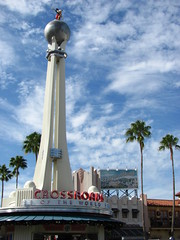
The lasting appeal of the Disney brand can likely be ascribed in part to the origin myths that surround the company’s founding. Everyone knows “it was all started by a mouse”, and the dedication of Disneyland, “to all who come to this happy place, welcome,” is more entrenched in the cultural consciousness than a majority of inauguration speeches made by U.S. presidents. The lands found in the parks themselves are frequently origin stories, most notably Main Street U.S.A. in both Disneyland and The Magic Kingdom which mythologizes Walt’s adolescent roots as an American dreamer. Even after Walt, the EPCOT Center had a special creation myth as well, retold by fans about the original vision for an “Experimental Prototype Community of Tomorrow” and how it evolved into the Epcot we know today. These original parks in the Disney family are often considered timeless creations, whereas Disney’s Hollywood Studios (formerly Disney-MGM Studios before the licensing contract expired) would probably rather we forget the time of its creation altogether. Its origin story goes something like this:
When Universal Studios announced their plans to build a movie theme park in Orlando, Michael Eisner quickly scrambled together a press conference to announce his own plans for a third gate at Walt Disney World, which looked suspiciously identical to the proposed movie theme from their soon-to-be competitors. Using some ride concepts from unused proposals for their existing parks, Disney-MGM Studios managed to complete a year ahead of Universal Studios despite the later construction start, partly thanks to the Disney Company’s special jurisdiction in Florida that lets them issue their own construction permits. Upon opening their gates, visitors to Disney-MGM Studios were treated to a grand total of four different attractions to fill out their day of adventure, as well as a separate movie production studio which gave us such classics as Ernest Saves Christmas and Thunder in Paradise before it was eventually downsized back to California… not that that fact should be any reason they can’t still pretend that we get to watch real movies and television be made. park in Orlando, Michael Eisner quickly scrambled together a press conference to announce his own plans for a third gate at Walt Disney World, which looked suspiciously identical to the proposed movie theme from their soon-to-be competitors. Using some ride concepts from unused proposals for their existing parks, Disney-MGM Studios managed to complete a year ahead of Universal Studios despite the later construction start, partly thanks to the Disney Company’s special jurisdiction in Florida that lets them issue their own construction permits. Upon opening their gates, visitors to Disney-MGM Studios were treated to a grand total of four different attractions to fill out their day of adventure, as well as a separate movie production studio which gave us such classics as Ernest Saves Christmas and Thunder in Paradise before it was eventually downsized back to California… not that that fact should be any reason they can’t still pretend that we get to watch real movies and television be made.
In retrospect the origins of today’s Disney’s Hollywood Studios probably seem a bit silly and misguided. Even given that it has higher annual attendance than Universal Studios by virtue of being part of the Disney World package,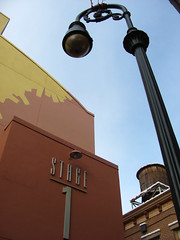 as the smallest of three (now four) gates the motivation for Disney’s Studios park to compete would never be as great as Universal’s focus of resources would be on their flagship property. The similarities and differences between the two parks today are telling. Both promised a peek behind the scenes of moviemaking even though both have ill-fated histories of actual movie production in Florida, and both have relatively uninspiring visual identities, simulating soundstages and movie sets that even if real wouldn’t have much innate aesthetic appeal anyway.1 Both parks also tend to be treated as the dumping grounds for intellectual properties their parent companies want to build a ride out of but wouldn’t quite fit behind their other more thematically structured gates. as the smallest of three (now four) gates the motivation for Disney’s Studios park to compete would never be as great as Universal’s focus of resources would be on their flagship property. The similarities and differences between the two parks today are telling. Both promised a peek behind the scenes of moviemaking even though both have ill-fated histories of actual movie production in Florida, and both have relatively uninspiring visual identities, simulating soundstages and movie sets that even if real wouldn’t have much innate aesthetic appeal anyway.1 Both parks also tend to be treated as the dumping grounds for intellectual properties their parent companies want to build a ride out of but wouldn’t quite fit behind their other more thematically structured gates.
However, where Universal Studios Florida became big and muscular by adding major attractions on a frequent basis whether they fit the surrounding environment or not, Disney’s Hollywood Studios’ growth has been more conservative, with fewer total E-ticket attractions that also tend to be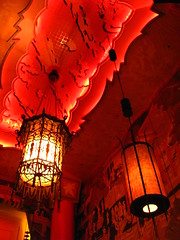 of more even quality, which has left many of the original themed environments still cohesively intact. There are more pathways and buildings around Hollywood Studios that are pleasurable to simply explore or admire the historical references at one’s own leisure (e.g. Sunset Blvd., Echo Lake), whereas Universal Studios emphasizes action with design choices intended to funnel us into the queue of the nearest attraction. Perpetually compared to the other three theme parks on Walt Disney World’s property, it can be easy to forget that if on its own Disney’s Hollywood Studios would still be a relatively beautiful park when inspected up close. of more even quality, which has left many of the original themed environments still cohesively intact. There are more pathways and buildings around Hollywood Studios that are pleasurable to simply explore or admire the historical references at one’s own leisure (e.g. Sunset Blvd., Echo Lake), whereas Universal Studios emphasizes action with design choices intended to funnel us into the queue of the nearest attraction. Perpetually compared to the other three theme parks on Walt Disney World’s property, it can be easy to forget that if on its own Disney’s Hollywood Studios would still be a relatively beautiful park when inspected up close.
The fact is easily forgotten because, stepping back from each example of the wonderful attention to detail and examining the park grounds as a whole, Disney’s Hollywood Studios has a fairly monotonous aesthetic identity, roughly divided into two sprawling sections: the Golden Age Tinseltown look in the northern half and the studio soundstage look on the south side, with a few lone areas of IP-based attractions adding discontinuous lumps to the mix. While the other Walt Disney World parks use their environments to evoke universal stories of reassurance, wonder, or nature, Hollywood Studios by contrast is both narrow in concept and narcissistic in delivery. It’s a vanity project designed primarily to please the old guard of Hollywood executives who built it in the first place. A place to reminisce over how easy it used to be to deceive audiences with either a little glitz and glamour on the red carpet or some make-up and special effects on the silver screen, while assuming that modern audiences still share that same nostalgic desire to be duped by these manufactured illusions of the culture industry.2 The phrase “you ought to be in pictures” is glimpsed several times to remind us that the ability to make it into Hollywood should still be considered the highest endorsement of an individual’s beauty and self-worth, even if most people today would interpret such a sentiment as cutely quaint rather than truly honorary. Therefore it’s perhaps of interest to note that two of the most original attractions, The Twilight Zone Tower of Terror and Muppet*Vision 3D, are both to some degree deconstructions of the vainglorious attitudes towards movie magic that define the rest of this theme park. by contrast is both narrow in concept and narcissistic in delivery. It’s a vanity project designed primarily to please the old guard of Hollywood executives who built it in the first place. A place to reminisce over how easy it used to be to deceive audiences with either a little glitz and glamour on the red carpet or some make-up and special effects on the silver screen, while assuming that modern audiences still share that same nostalgic desire to be duped by these manufactured illusions of the culture industry.2 The phrase “you ought to be in pictures” is glimpsed several times to remind us that the ability to make it into Hollywood should still be considered the highest endorsement of an individual’s beauty and self-worth, even if most people today would interpret such a sentiment as cutely quaint rather than truly honorary. Therefore it’s perhaps of interest to note that two of the most original attractions, The Twilight Zone Tower of Terror and Muppet*Vision 3D, are both to some degree deconstructions of the vainglorious attitudes towards movie magic that define the rest of this theme park.
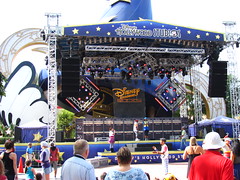 All told Disney’s Hollywood Studios is still a worthwhile entry amongst Central Florida’s theme park selection, if not only because it has a collection of attractions with greater appeal to most ride enthusiasts than the average Disney park. Perhaps what it needs more than anything else could be as simple as a proper central icon instead of the Sorcerer’s Hat placed there “temporarily” since 2001. Something that could give the complete park a more unified, universal message, instead of a slapdash icon reminding us of the park’s slapdash heritage built by competing corporate egos with evidently very little imagination left in the world. All told Disney’s Hollywood Studios is still a worthwhile entry amongst Central Florida’s theme park selection, if not only because it has a collection of attractions with greater appeal to most ride enthusiasts than the average Disney park. Perhaps what it needs more than anything else could be as simple as a proper central icon instead of the Sorcerer’s Hat placed there “temporarily” since 2001. Something that could give the complete park a more unified, universal message, instead of a slapdash icon reminding us of the park’s slapdash heritage built by competing corporate egos with evidently very little imagination left in the world.
The Great Movie Ride
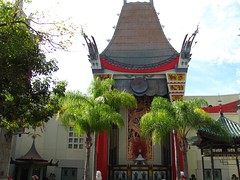 Here’s a dark ride built by geeks for geeks. At first the uninspired descriptive title and central placement as Hollywood Studio’s “mascot” attraction (à la Cinderella Castle or Spaceship Earth, this time with Mann’s Chinese Theatre) made me fear this could be a very vanilla work of Hollywood pageantry, overproduced as only Disney knows how. Thankfully that’s not (entirely) the case, as the show producers seem to demonstrate a genuine giddy enthusiasm for toying with many conventions of theme park attractions while simultaneously flattering our pop-culture savvy. Like, “wouldn’t-it-be-cool-if-the-ride-host-gets-kidnapped-by-a-villain-from-a-gangster-flick-or-spaghetti-western”, and “wouldn’t-it-be-cooler-if-then-the-gangster-gets-owned-by-the-xenomorph-from-Alien”, but then “wouldn’t-it-be-coolest-if-he-gets-his- Here’s a dark ride built by geeks for geeks. At first the uninspired descriptive title and central placement as Hollywood Studio’s “mascot” attraction (à la Cinderella Castle or Spaceship Earth, this time with Mann’s Chinese Theatre) made me fear this could be a very vanilla work of Hollywood pageantry, overproduced as only Disney knows how. Thankfully that’s not (entirely) the case, as the show producers seem to demonstrate a genuine giddy enthusiasm for toying with many conventions of theme park attractions while simultaneously flattering our pop-culture savvy. Like, “wouldn’t-it-be-cool-if-the-ride-host-gets-kidnapped-by-a-villain-from-a-gangster-flick-or-spaghetti-western”, and “wouldn’t-it-be-cooler-if-then-the-gangster-gets-owned-by-the-xenomorph-from-Alien”, but then “wouldn’t-it-be-coolest-if-he-gets-his- face-melted-like-the-guy-in-Indiana-Jones-and-the-guardian-of-the-Ark-of-the-Covenant-turns-out-is-the-original-ride-host-in-disguise”? (Deep breath.) Given how many different ideas the Imagineers tried to cram together The Great Movie Ride easily could have suffered from over complication, but… well, okay, it is a little over complicated. Sure that’s part of the charm, but mixing live performers with audio-animatronics on the same stage almost always produces extra awkward results, and the script’s handful of “spontaneous surprises” often play stale or forced, simply due to the nature of a theme park attraction that requires casts members to read the same lines every twenty minutes every day for the rest of their career. The Great Movie Ride wants us to admire its cleverness and craftsmanship, but it’s mostly just an expensive work of fan fiction; an emotional parasite face-melted-like-the-guy-in-Indiana-Jones-and-the-guardian-of-the-Ark-of-the-Covenant-turns-out-is-the-original-ride-host-in-disguise”? (Deep breath.) Given how many different ideas the Imagineers tried to cram together The Great Movie Ride easily could have suffered from over complication, but… well, okay, it is a little over complicated. Sure that’s part of the charm, but mixing live performers with audio-animatronics on the same stage almost always produces extra awkward results, and the script’s handful of “spontaneous surprises” often play stale or forced, simply due to the nature of a theme park attraction that requires casts members to read the same lines every twenty minutes every day for the rest of their career. The Great Movie Ride wants us to admire its cleverness and craftsmanship, but it’s mostly just an expensive work of fan fiction; an emotional parasite that survives by feeding off superior works of art. Sure the satisfaction of winning a game of “Spot the Movie References” can be real, it’s just also not very deep. that survives by feeding off superior works of art. Sure the satisfaction of winning a game of “Spot the Movie References” can be real, it’s just also not very deep.
Grade: C+
Indiana Jones Epic Stunt Spectacular!
Of course everything at a Disney park is fake, but sometimes the fakery is directly acknowledged while (most) other times our disbelief is supposed to be suspended indefinitely. There’s an extended bit where one of the group of audience members they bring on stage is actually a plant, which our initial ignorance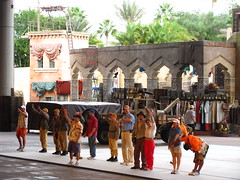 of the confederate’s presence allows for some amusing did-that-really-just-happen gags. When the set culminates in an outrageous stunt that instantly clues everyone into the act, the show wisely doesn’t try to stretch our disbelief any further and immediately acknowledges the ruse so that everyone can authentically cheer a fine performance (one most didn’t even realize was a performance twenty seconds earlier). Well played, and enjoyable entertainment. Given that the majority of the Indiana Jones Epic Stunt Spectacular doesn’t try to be a work of theater but just an honest demonstration of the physical stunts and special effects that make movie magic, it’s therefore more conspicuously odd when the show writers do try to enforce an obviously fictional conceit. The worst offender is the repeated claims to convince us this set is actually used of the confederate’s presence allows for some amusing did-that-really-just-happen gags. When the set culminates in an outrageous stunt that instantly clues everyone into the act, the show wisely doesn’t try to stretch our disbelief any further and immediately acknowledges the ruse so that everyone can authentically cheer a fine performance (one most didn’t even realize was a performance twenty seconds earlier). Well played, and enjoyable entertainment. Given that the majority of the Indiana Jones Epic Stunt Spectacular doesn’t try to be a work of theater but just an honest demonstration of the physical stunts and special effects that make movie magic, it’s therefore more conspicuously odd when the show writers do try to enforce an obviously fictional conceit. The worst offender is the repeated claims to convince us this set is actually used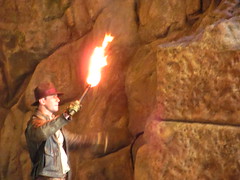 for filming movies, as if studio films are produced with live studio audiences and being a Harrison Ford stunt double for the Indiana Jones franchise is a steady career with regular 9-5 working hours, ideal for the muscular 20-something theater grads they’ve hired. Maybe this premise worked for one year in 1989 when this show first debuted and the Last Crusade opened in theaters featuring a still youthful Mr. Ford, but today it’s just a distracting reminder of how Disney can’t be bothered to update even a few lines of script for a live performance in over twenty years. It also suggests the writers don’t have confidence to let their show stand on its own merits; don’t worry, no one will be disappointed to learn that your theme park stunt show isn’t real and is really only there to entertain audiences in a theme park with stunts. for filming movies, as if studio films are produced with live studio audiences and being a Harrison Ford stunt double for the Indiana Jones franchise is a steady career with regular 9-5 working hours, ideal for the muscular 20-something theater grads they’ve hired. Maybe this premise worked for one year in 1989 when this show first debuted and the Last Crusade opened in theaters featuring a still youthful Mr. Ford, but today it’s just a distracting reminder of how Disney can’t be bothered to update even a few lines of script for a live performance in over twenty years. It also suggests the writers don’t have confidence to let their show stand on its own merits; don’t worry, no one will be disappointed to learn that your theme park stunt show isn’t real and is really only there to entertain audiences in a theme park with stunts.
Grade: C-
Star Tours – The Adventures Continue
Some people can’t do roller coasters, while others get queasy on spinning flat rides. I’ll be honest: my Achilles’ heel seems to be motion simulator rides. Sure I can ride them, but sitting in a claustrophobic bouncing box in front of the dim flicker of a 3D movie screen while concentrating my eyes on an artificial focal length, it doesn’t take long before the back of my retinas start to strain and the bottom of my stomach begins to tighten. Surprisingly, I find neither sensation to be particularly enjoyable. Thus the revamped Star Tours, which touts an impressive 54 different film sequences for a new adventure each time, could easily become something of a curse for a completionist prone to motion sickness such as myself. Still, with the aid of Dramamine and FastPasses I managed a total of four rides before having to call it quits, and that was more because of my annoyance that my fourth ride consisted of segments I had already seen at least twice while a handful of possible scenes continued to elude me. As an experiential short film set in the Star Wars universe there’s no doubt that Star Tours is tremendously successful at what it does, and the randomized sequences to encourage multiple re-rides is a long overdue idea to extract more value for repeat visitors at a lower marginal expense to the designers,3 even though there’s really only three revamped Star Tours, which touts an impressive 54 different film sequences for a new adventure each time, could easily become something of a curse for a completionist prone to motion sickness such as myself. Still, with the aid of Dramamine and FastPasses I managed a total of four rides before having to call it quits, and that was more because of my annoyance that my fourth ride consisted of segments I had already seen at least twice while a handful of possible scenes continued to elude me. As an experiential short film set in the Star Wars universe there’s no doubt that Star Tours is tremendously successful at what it does, and the randomized sequences to encourage multiple re-rides is a long overdue idea to extract more value for repeat visitors at a lower marginal expense to the designers,3 even though there’s really only three different sequences of significance that can be randomly rearranged in four spots like a Twist-and-Match toy figurine. For anyone who hasn’t already sworn allegiance to the Rebel Alliance before boarding their StarSpeeder, they may find that this lottery ball approach to storytelling shares a lot of the same narrative deficiencies as any other “Choose Your Own Adventure” story… and here you don’t even have the freedom to choose. Instead of 54 equally interchangeable riffs on the same concept, wouldn’t we have been better off choosing between three complete and completely different story arcs? different sequences of significance that can be randomly rearranged in four spots like a Twist-and-Match toy figurine. For anyone who hasn’t already sworn allegiance to the Rebel Alliance before boarding their StarSpeeder, they may find that this lottery ball approach to storytelling shares a lot of the same narrative deficiencies as any other “Choose Your Own Adventure” story… and here you don’t even have the freedom to choose. Instead of 54 equally interchangeable riffs on the same concept, wouldn’t we have been better off choosing between three complete and completely different story arcs?
Grade: C
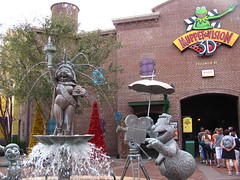 Muppet*Vision 3D Muppet*Vision 3D
3D/4D movie attractions usually rank below average on the theme park attraction totem pole, but I must make an exception in this case. Here is what separates Muppet*Vision 3D from the rest: Love. Jim Henson and company took the time to write a genuinely clever script full of their typically absurdist humor, which would sadly become Henson’s last time voicing Kermit the Frog before his death in 1990. Nothing is safe from the anarchy of the Muppets, who this time set a lock on both theme parks and movie production as a primary subject of their merciless slapstick, which lends the film some deliciously contextual satiric relevance. Targets include the cheap gimmicks 3D movies typically employ to elicit an audience reaction by reaching through the screen for no reason related to the story; the artificiality of “lifelike” audio-animatronics who are in fact bolted in place and thus can never, ahem, relieve themselves between shows; and most hilariously, a parody/veiled critique of Epcot’s World Showcase in the form of Sam the Eagle’s patriotic final act titled “A Salute to All Nations, But Mostly America”. While sometimes the manic energy starts to run around in circles with no objective in sight, the only real downside of Muppet*Vision 3D that would cause hesitation over a second viewing is an interminable preshow that keeps everyone on their feet for much longer than seems necessary. Otherwise this is possibly the best 3D movie attraction currently playing at a major theme park. an audience reaction by reaching through the screen for no reason related to the story; the artificiality of “lifelike” audio-animatronics who are in fact bolted in place and thus can never, ahem, relieve themselves between shows; and most hilariously, a parody/veiled critique of Epcot’s World Showcase in the form of Sam the Eagle’s patriotic final act titled “A Salute to All Nations, But Mostly America”. While sometimes the manic energy starts to run around in circles with no objective in sight, the only real downside of Muppet*Vision 3D that would cause hesitation over a second viewing is an interminable preshow that keeps everyone on their feet for much longer than seems necessary. Otherwise this is possibly the best 3D movie attraction currently playing at a major theme park.
Grade: B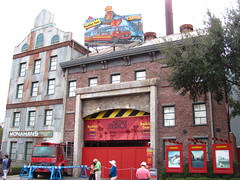
Studio Backlot Tour
This was closed for refurbishment at the time of my visit. I missed out on the Studio Tour at the sister park in Paris for the same reason, and having done all but one of the Universal parks, the one I’m still missing would also be the only one that has a studio tour. One of these days I’ll finally get to sit on a tram and be shuttled between movie sets accompanied by the cadence of a chirpy tour guide, but that day would not be today. That’s more time for Tower rides, then.
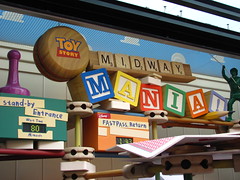 Toy Story Midway Mania! Toy Story Midway Mania!
With Toy Story Midway Mania the interactive shooter dark ride format has reached its apogee. Never again in the future of mankind will a dark ride equipped with a plastic wank gun be as gleefully fun as this ride is. Hooray. Now that we won’t need any more attractions that combine beloved children’s characters with the central mechanic from the “Deer Hunter” videogame series, can we please go back to making dark rides where the focus is on things like story and atmosphere and other arty crap? Between the HD-3D video screens that immerse you in the game like it’s the world’s largest iPad; the real-time projectile rings, darts, and balls that ricochet off scenery with supreme anarchic satisfaction;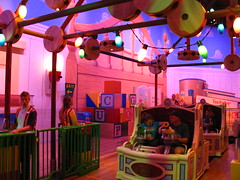 or the way vehicles suddenly yank and spin you from one level to the next imbuing the game with a physical sense of urgency… it’s impossible to make this formula more entertaining without controlled substances. And I’m not being (completely) sarcastic. Ride it once for what will seem like the second-best four minutes of your life so you’ll never have to bother again. Beware, the line fills up fast, so get a FastPass early in the day and do it quick before Mr. Potato Head has another aneurysm. or the way vehicles suddenly yank and spin you from one level to the next imbuing the game with a physical sense of urgency… it’s impossible to make this formula more entertaining without controlled substances. And I’m not being (completely) sarcastic. Ride it once for what will seem like the second-best four minutes of your life so you’ll never have to bother again. Beware, the line fills up fast, so get a FastPass early in the day and do it quick before Mr. Potato Head has another aneurysm.
Grade: C
The Magic of Disney Animation
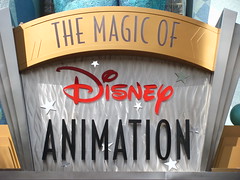 This indoor complex houses several different attractions, including a show about animated character development, costumed character meet-and-greets (there are always meet-and-greets at Disney parks, and they often command some of the longest lines), interactive games, and a museum of Disney animation artwork. The combination live/projected show actually does offer some worthwhile insights into Disney’s creative process, even if the show writers seemed to lack confidence over the audience’s sustained interest in this material by overstuffing the script with throwaway gags. The interactive activities on the main floor are fairly unremarkable, not helped by the recent proliferation of the App marketplace that now makes large computer kiosks housing mini-games such as these almost entirely redundant. This indoor complex houses several different attractions, including a show about animated character development, costumed character meet-and-greets (there are always meet-and-greets at Disney parks, and they often command some of the longest lines), interactive games, and a museum of Disney animation artwork. The combination live/projected show actually does offer some worthwhile insights into Disney’s creative process, even if the show writers seemed to lack confidence over the audience’s sustained interest in this material by overstuffing the script with throwaway gags. The interactive activities on the main floor are fairly unremarkable, not helped by the recent proliferation of the App marketplace that now makes large computer kiosks housing mini-games such as these almost entirely redundant. It’s cute that a program script can determine after six short questions that if I were a Disney character I would be Jafar from Aladdin (I couldn’t disagree), but in this decade do I really still need to travel to Florida for that information? The adjoining museum about Disney animation is perhaps the most worthwhile, even if (and perhaps this is simply due to the nature of animation) the exhibits are very two-dimensional and the experience is akin to a coffee table book you have to read while standing. Nevertheless I walked away with some newfound appreciation for the artwork in a number of classic and recent animated films I hadn’t previously given as much consideration to, which seems like a solid signal that this gallery must be a success.4 It’s cute that a program script can determine after six short questions that if I were a Disney character I would be Jafar from Aladdin (I couldn’t disagree), but in this decade do I really still need to travel to Florida for that information? The adjoining museum about Disney animation is perhaps the most worthwhile, even if (and perhaps this is simply due to the nature of animation) the exhibits are very two-dimensional and the experience is akin to a coffee table book you have to read while standing. Nevertheless I walked away with some newfound appreciation for the artwork in a number of classic and recent animated films I hadn’t previously given as much consideration to, which seems like a solid signal that this gallery must be a success.4
Grade: C-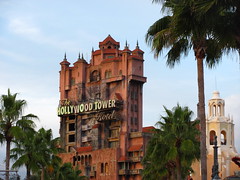
The Twilight Zone Tower of Terror
Tower of Terror could make the best argument of any Disney ride that a theme park attraction could be considered as a uniquely singular category of artistic storytelling. It’s not that there aren’t better or more artistically competent Disney attractions (although the list is very short), but it is the only one that makes the exclusive experiential capability of thrill ride hardware and environmental immersion an absolutely essential component to the articulation of a detailed narrative. As great – in fact, greater – as the similarly weird and wonderful Haunted Mansion is, the slow-moving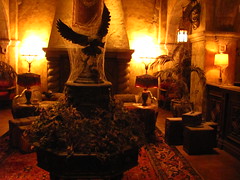 vehicles gliding gently past a fixed series of scenes could be translated into a different visual story medium without significant compromise, whereas a plot in which the audience must personally experience a zero-gravity freefall down an elevator shaft could not be replicated anywhere outside the theme park medium.5 The story, culled from an episode of the Twilight Zone, offers a breathtaking impression of Hollywood’s Golden Age as a source of simultaneous beauty and moral decay, cursed by the specter of time as familiar objects (including our own faces) phase in and out of the stardust from whence we came. In no other work of fiction has the existential dread rising from the pit of our stomach been felt so literally. vehicles gliding gently past a fixed series of scenes could be translated into a different visual story medium without significant compromise, whereas a plot in which the audience must personally experience a zero-gravity freefall down an elevator shaft could not be replicated anywhere outside the theme park medium.5 The story, culled from an episode of the Twilight Zone, offers a breathtaking impression of Hollywood’s Golden Age as a source of simultaneous beauty and moral decay, cursed by the specter of time as familiar objects (including our own faces) phase in and out of the stardust from whence we came. In no other work of fiction has the existential dread rising from the pit of our stomach been felt so literally.
Yet while Tower of Terror could make the strongest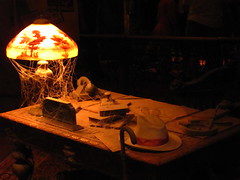 argument for the story-ride fusion as a unique artistic medium, I’m frustrated by certain aspects that weaken this position. There are hints of intriguing ideas that could form the bedrock of a great popular science fiction story; e.g. Hollywood’s downfall reinterpreted as a modern Icarus myth featuring an iconic tower that reached for the sun only to fall when it got too close, or the notion that the familiar world is an illusory construct of ancient metaphysical entities. However there’s also a sense that any deeper interpretations are mere thematic ghosts left behind from the television show, and discussion over the story’s meaning would be more relevant to the source material than the watered-down remix in the attraction. Most of the narrative details are isolated to the corner of a dark room where a sixteen inch television screen6 quickly answers argument for the story-ride fusion as a unique artistic medium, I’m frustrated by certain aspects that weaken this position. There are hints of intriguing ideas that could form the bedrock of a great popular science fiction story; e.g. Hollywood’s downfall reinterpreted as a modern Icarus myth featuring an iconic tower that reached for the sun only to fall when it got too close, or the notion that the familiar world is an illusory construct of ancient metaphysical entities. However there’s also a sense that any deeper interpretations are mere thematic ghosts left behind from the television show, and discussion over the story’s meaning would be more relevant to the source material than the watered-down remix in the attraction. Most of the narrative details are isolated to the corner of a dark room where a sixteen inch television screen6 quickly answers the perfunctory Who-What-Where-When bullet points from the storyteller’s manual while leaving the more interesting questions of How and Why largely unanswered. Perhaps this could be seen as a minimalist approach to story intended to foster suspense and encourage visitors to reach their own conclusions, but more realistically this brief and overly-expository video suggests that engagement with such questions was never intended in the first place. As long as the preshow provides adequate justification for the falling elevator concept and finishes with an eerie feeling of mystery, it matters not if the story has any deeper independent meaning. In this case “story” or “theme” becomes a means to an end: it’s window dressing there for those who would admire it the same way as they will distantly admire the set design or special effects, the perfunctory Who-What-Where-When bullet points from the storyteller’s manual while leaving the more interesting questions of How and Why largely unanswered. Perhaps this could be seen as a minimalist approach to story intended to foster suspense and encourage visitors to reach their own conclusions, but more realistically this brief and overly-expository video suggests that engagement with such questions was never intended in the first place. As long as the preshow provides adequate justification for the falling elevator concept and finishes with an eerie feeling of mystery, it matters not if the story has any deeper independent meaning. In this case “story” or “theme” becomes a means to an end: it’s window dressing there for those who would admire it the same way as they will distantly admire the set design or special effects, and for everyone else it’s an excuse to put a drop tower ride in a Disney park. Given that the majority of people will exit chattering excitedly over what the ride did rather than what the ride was about, I can’t help but feel that for all Tower of Terror does right, the formula to make theme park attractions a “story-first” medium has yet to find the perfect balance. and for everyone else it’s an excuse to put a drop tower ride in a Disney park. Given that the majority of people will exit chattering excitedly over what the ride did rather than what the ride was about, I can’t help but feel that for all Tower of Terror does right, the formula to make theme park attractions a “story-first” medium has yet to find the perfect balance.
Grade: B+
Rock ‘n’ Roller Coaster
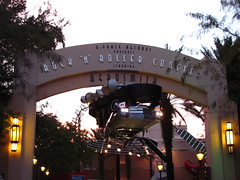 Okay Disney, we get it: you can be just as much of a badass as Universal Studios. The regrettably short-lived Hard Rock Park still beat both of your attempts at rock idolatry, as that property was created by people who evidenced a true love for the music unlike these poseurs sitting at the cool kid’s table in central Florida. So, Rock ‘n’ Roller Coaster is actually a pretty good Disney attraction while simultaneously being a pretty mediocre roller coaster.7 The show portion of the attraction (i.e. everything built by Imagineers) is simultaneously very “counter-Disney” while also extremely “classic Disney”, and I respect the balancing act needed to make this original concept (at the time) work. The visual aesthetic, which transitions from an ultra-modernist recording studio (the attraction’s “cover art”, as it were) to a dark and grungy backstage area Okay Disney, we get it: you can be just as much of a badass as Universal Studios. The regrettably short-lived Hard Rock Park still beat both of your attempts at rock idolatry, as that property was created by people who evidenced a true love for the music unlike these poseurs sitting at the cool kid’s table in central Florida. So, Rock ‘n’ Roller Coaster is actually a pretty good Disney attraction while simultaneously being a pretty mediocre roller coaster.7 The show portion of the attraction (i.e. everything built by Imagineers) is simultaneously very “counter-Disney” while also extremely “classic Disney”, and I respect the balancing act needed to make this original concept (at the time) work. The visual aesthetic, which transitions from an ultra-modernist recording studio (the attraction’s “cover art”, as it were) to a dark and grungy backstage area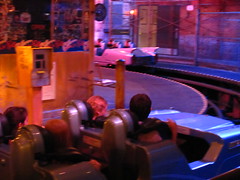 (where the heart of rock ‘n’ roll is found), are both quite different from anything else found on Walt Disney World property with its traditional focus on reassuring fantasies and nostalgia. Yet the Rock ‘n’ Roller Coaster is hardly antiestablishment, as most of the traditions of Disney design are still present underneath it all; from the series of enchanted portals that gradually take us someplace removed from the everyday, to the abundant nostalgia that comforts us like a friendly hug… only this time for a generation that cherishes memorabilia from The Doors or Jimi Hendrix Experience rather than the typical 1950’s cultural iconography of other Disney parks. Unfortunately the coaster portion of the attraction (i.e. everything built by Vekoma) is also pretty last generational as well. Predictably there’s no sense of how to pace a layout so it’s exciting (where the heart of rock ‘n’ roll is found), are both quite different from anything else found on Walt Disney World property with its traditional focus on reassuring fantasies and nostalgia. Yet the Rock ‘n’ Roller Coaster is hardly antiestablishment, as most of the traditions of Disney design are still present underneath it all; from the series of enchanted portals that gradually take us someplace removed from the everyday, to the abundant nostalgia that comforts us like a friendly hug… only this time for a generation that cherishes memorabilia from The Doors or Jimi Hendrix Experience rather than the typical 1950’s cultural iconography of other Disney parks. Unfortunately the coaster portion of the attraction (i.e. everything built by Vekoma) is also pretty last generational as well. Predictably there’s no sense of how to pace a layout so it’s exciting to the very end. The launch is cool (the use of lighting makes it look much faster than it really is, about twice as strong as a commercial airliner takeoff) and it immediately pours into the signature double rollover maneuver. After that the bulky limo-train lumbers around a series of flat geometric curves and block brakes with a lone corkscrew making a cameo appearance at some arbitrary midpoint. Basically a rip-off of the Premier-built Flight of Fear coasters that opened three years prior, lacking are the nimble directional changes, strategic lulls and crescendos, and final corkscrew that forcefully informs you of the finish. Of course the coaster component isn’t all that matters, but given that Disney thought it mattered enough to break the diegetic construct and put “Roller Coaster” in the very title, I don’t feel out of line asking for better. to the very end. The launch is cool (the use of lighting makes it look much faster than it really is, about twice as strong as a commercial airliner takeoff) and it immediately pours into the signature double rollover maneuver. After that the bulky limo-train lumbers around a series of flat geometric curves and block brakes with a lone corkscrew making a cameo appearance at some arbitrary midpoint. Basically a rip-off of the Premier-built Flight of Fear coasters that opened three years prior, lacking are the nimble directional changes, strategic lulls and crescendos, and final corkscrew that forcefully informs you of the finish. Of course the coaster component isn’t all that matters, but given that Disney thought it mattered enough to break the diegetic construct and put “Roller Coaster” in the very title, I don’t feel out of line asking for better.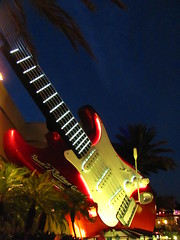
Grade: C+
Summary
A typical product of Hollywood’s most self-congratulatory impulses, some high-grade attractions save Disney’s Hollywood Studios from obsolescence in the competitive Orlando market.
Overall Grade: C
Marne la Vallée, France – Monday, March 22nd, 2010
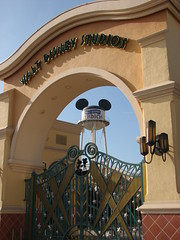
If I was unsure what my reaction to Disneyland Paris the previous day would be, I was even less sure of what I’d think of the Walt Disney Studios Park located next door. Disneyland Park at least was universally well-reviewed, it was just a question of whether I’d ‘get’ that whole Disney mindset. The Studios park, on the other hand, I had heard some – if not bad – at least tepid things about, that it lacked enough things to do or its own identity, or was just sort of thrown together to give the Disneyland Paris complex a marketing boost after it failed to live up to expectations in its first few years. The big difference is Disneyland Park is themed to fantastic worlds of the imagination, while the Studios Park is themed to movie warehouses. How’s that fair?
My hotel was one stop RER train stop away from the Disney complex in Val d’Europe (I stayed in a place called the Etap Marne la Vallée, I’d recommend it if you’re on a budget since it’s fairly new, costs less than €50 a night, and is a very short walk from the train station) so I planned to get to the Studios Park close to ten so I could get a ride or two on Crush’s Coaster before the lines for that one started filling up. I got to the gates less than five minutes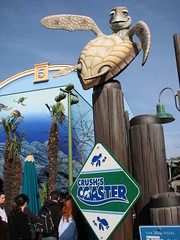 after opening at 10am, found the place didn’t look very crowded being a Monday in March, and went straight to the Toon Studios section where I found Crush’s Coaster was posting an 80 minute wait. Huh? Sure enough, it somehow already managed to collect a full queue. In reality it would have been about half of that, except for it broke down for close to a half hour which did put the wait at around 75 minutes or so. Not the best way to start the day. after opening at 10am, found the place didn’t look very crowded being a Monday in March, and went straight to the Toon Studios section where I found Crush’s Coaster was posting an 80 minute wait. Huh? Sure enough, it somehow already managed to collect a full queue. In reality it would have been about half of that, except for it broke down for close to a half hour which did put the wait at around 75 minutes or so. Not the best way to start the day.
It might have been a mistake to choose this Maurer spinning coaster system since the single four-person cars, even with their fast, steady dispatches, still can’t meet the capacity demanded by a Disney park on even an incredibly lightly attended day such as this one. As a result I had to make this my only ride on Crush’s Coaster for the entire day, which was a shame because it might very well be the best ride in the park (plus it’s the only major attraction of theirs that is still totally unique to the Paris Studios Park). The platform area is dressed up in a very attractive “Australian harbor at sunset” setting straight from Finding Nemo, which was sort of weird feeling since it was still morning. The spinning cars work well as turtle shells, my suspicion this is 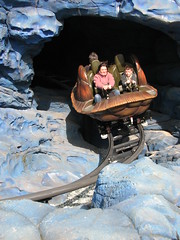 why Maurer won the contract, although Mack’s spinners could work just as well, and their model allows for multi-car trains and a higher capacity. why Maurer won the contract, although Mack’s spinners could work just as well, and their model allows for multi-car trains and a higher capacity.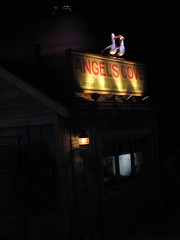
The pre-ride starts out with a small lift hill right out of the station. From here there’s a small right-hand dive into an outdoor stretch of track that works as a photo opportunity for onlookers to get a shot of the ride in action. It just as quickly zips back indoors. I imagined that after this it would go straight into the main chain lift, but the dark ride continues for another couple of block segments, past scenes of jellyfish and the dreaded anglerfish, and then upon engaging the lift hill there’s a long pipe from the “sunken warship” part of the movie with an effective (and large) Bruce animatronic that surprises us at the end. Cool stuff.
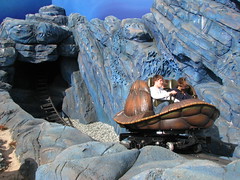 Then we get to the top, and the ride promptly suffers from what should probably be called “Dark Knight Syndrome”. Namely, after a greatly themed pre-ride section, it disappointingly culminates into a Coaster-in-a-Box. There’s actually fewer props on the main section of Crush’s Coaster than on the Dark Knight; in fact, there’s none. Swirling disco balls meant to give the effect of rushing bubbles in the EAC are pretty much all this ride was outfitted for. But unlike Dark Knight, I’m sort of okay with this setup. The layout isn’t a bunch of low-speed switchbacks, but is rather fast and intense, and with as much spinning as we got I doubt I could see anything anyway (actually, I don’t know, maybe there were props inside it that I could never focus on). Apart from being a Coaster-in-a-Box it’s exactly the same as Waldameer’s Steel Dragon Then we get to the top, and the ride promptly suffers from what should probably be called “Dark Knight Syndrome”. Namely, after a greatly themed pre-ride section, it disappointingly culminates into a Coaster-in-a-Box. There’s actually fewer props on the main section of Crush’s Coaster than on the Dark Knight; in fact, there’s none. Swirling disco balls meant to give the effect of rushing bubbles in the EAC are pretty much all this ride was outfitted for. But unlike Dark Knight, I’m sort of okay with this setup. The layout isn’t a bunch of low-speed switchbacks, but is rather fast and intense, and with as much spinning as we got I doubt I could see anything anyway (actually, I don’t know, maybe there were props inside it that I could never focus on). Apart from being a Coaster-in-a-Box it’s exactly the same as Waldameer’s Steel Dragon 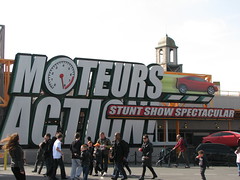 which I liked quite a bit, and this one is certainly no less of a ride, so I must give it a positive rating. Still wish I could have gotten more rides on it. which I liked quite a bit, and this one is certainly no less of a ride, so I must give it a positive rating. Still wish I could have gotten more rides on it.
After Crush’s Coaster I got a fast pass for Tower of Terror and then moved on to the opposite side of the park to hit up the Rock ‘n’ Roller Coaster, except for that it was closed due to mechanical reasons. The Moteurs… Action! Stunt Show next door appeared to have just let in a line of people, so I quickly decided to join that instead. There was no hurry, as they continued to let people in for a good 25 minutes after I found a seat, with nothing to do. Here was a good reason for checking one’s park guide to figure out when the official show start times are, as I could have easily fit in another nearby attraction in the time I spent sitting 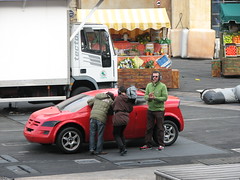 and checking my cellphone clock wondering when this was going to get underway (not that there were any other nearby attractions, at least ones that were open). It finally started and it was pretty much what I expected: lots of car tricks involving handbrakes, lots of motorcycles doing wheelies, five-minute buildups to a stunt that lasts five seconds, a couple bits of comic relief, a couple of big fireballs, and all done under the pretense that this is how movies are made. I’m fairly certain real movies don’t shoot their action sequences all in one take using a three-camera sitcom set-up, nor that any movie would consist of watching from the exterior cars do choreographed handbrake spins around each other. It was at many times thrilling to watch, although I’d be shocked if there wasn’t a person in the audience secretly wishing to see an accident occur; and checking my cellphone clock wondering when this was going to get underway (not that there were any other nearby attractions, at least ones that were open). It finally started and it was pretty much what I expected: lots of car tricks involving handbrakes, lots of motorcycles doing wheelies, five-minute buildups to a stunt that lasts five seconds, a couple bits of comic relief, a couple of big fireballs, and all done under the pretense that this is how movies are made. I’m fairly certain real movies don’t shoot their action sequences all in one take using a three-camera sitcom set-up, nor that any movie would consist of watching from the exterior cars do choreographed handbrake spins around each other. It was at many times thrilling to watch, although I’d be shocked if there wasn’t a person in the audience secretly wishing to see an accident occur; 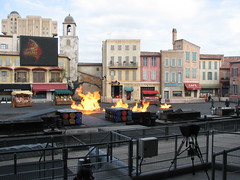 in that regard the show was a disappointment. At 45 minutes long it was at least a complete show, and again it was nearly as entertaining listening to the performers try to fit both French and English into the show and not have it come off as unnatural. in that regard the show was a disappointment. At 45 minutes long it was at least a complete show, and again it was nearly as entertaining listening to the performers try to fit both French and English into the show and not have it come off as unnatural.
Finishing with the show, which glorified special effects and Hollywood action tripe, I really do have to wonder if this entire park was even designed with a French market in mind. Total representation of French cinema: null. And no, Ratatouille does not count, which is expected to get an extensive dark ride in the next couple of years after the Toy Story Playland is finished. Now that I think about it, I do recall the Méliès brothers were briefly represented in history part of the Art of Animation, 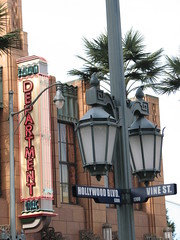 although that should be an absolute given no matter what country it’s located in. The degree of Americanization in the Studios Park is quite significant, even compared to the Disneyland Park next door, and while there might be a genuine market for this stuff in France, the phrase “cultural imperialism” continued to whisper gently in the back of my mind. Granted, I’ve not been in France for long enough to get a sense of what the average citizen’s relationship to Hollywood versus their own domestic cinema is, but I am rather stunned that they couldn’t accommodate any references to Jean-Luc Godard, François Truffaut, Jean-Pierre Melville, Henri-Georges Clouzot, or even Jacques Tati, at least none that I ever noticed. Not even Amélie, for christssake! I thought Disney Imagineers were supposed to take pleasure in putting little treats like that for fans that care enough to look for them to find… although it’s probably just as well that those French New Wave pioneers stayed as far away from any Disney association whatsoever, as I always feel jealous whenever something I thought was a personal, insider interest is appropriated by the same mainstream culture that celebrates James Horner soundtracks as a mark of cinematic excellence, it just makes them feel cheap. although that should be an absolute given no matter what country it’s located in. The degree of Americanization in the Studios Park is quite significant, even compared to the Disneyland Park next door, and while there might be a genuine market for this stuff in France, the phrase “cultural imperialism” continued to whisper gently in the back of my mind. Granted, I’ve not been in France for long enough to get a sense of what the average citizen’s relationship to Hollywood versus their own domestic cinema is, but I am rather stunned that they couldn’t accommodate any references to Jean-Luc Godard, François Truffaut, Jean-Pierre Melville, Henri-Georges Clouzot, or even Jacques Tati, at least none that I ever noticed. Not even Amélie, for christssake! I thought Disney Imagineers were supposed to take pleasure in putting little treats like that for fans that care enough to look for them to find… although it’s probably just as well that those French New Wave pioneers stayed as far away from any Disney association whatsoever, as I always feel jealous whenever something I thought was a personal, insider interest is appropriated by the same mainstream culture that celebrates James Horner soundtracks as a mark of cinematic excellence, it just makes them feel cheap.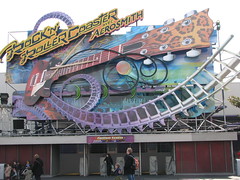
At some point the Rock ‘n’ Roller Coaster finally reopened, and unlike the Crush’s Coaster which had hour-plus waits all day, this one was consistently able to move through its queue in under ten minutes. The interior of the queue is modern, with lots of rock and roll posters and collectables on display sure to please the fans out there. That is, the fans that listen to English or American music as I couldn’t find one piece represented by a band that would sing (or scream) its lyrics in a language other than my own. Then we get to the preshow, which is a bit problematic for several reasons: 1), an attendant has us form two separate lines to get into it, but they let the first line fill up before sending people into the second. These remerge after the preshow, meaning that the people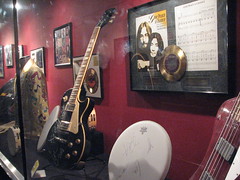 that got to fill in the beginning of the second line get to ‘cut’ in front of those put at the end of the first. 2), there’s going to be a lot of remixing of one’s relative position in the queue anyway since the preshow room is rather oversized leaving room for guests to mill around, and for the cleverer guests to mill around in the direction of the exit doors, at least as far as they can get without attracting the attention of other guests already at the front of the line who realize the same thing. 3), this issue of line-jumping does matter, since after a preshow which is supposed to get everyone amped up for the imminent ride there’s still a ten minute wait on the other side. 4), there’s no point to this preshow anyway since it’s about thirty seconds long and sets up no back story or anything (as far as I could tell the band is building a roller coaster and they want you to ride it… that got to fill in the beginning of the second line get to ‘cut’ in front of those put at the end of the first. 2), there’s going to be a lot of remixing of one’s relative position in the queue anyway since the preshow room is rather oversized leaving room for guests to mill around, and for the cleverer guests to mill around in the direction of the exit doors, at least as far as they can get without attracting the attention of other guests already at the front of the line who realize the same thing. 3), this issue of line-jumping does matter, since after a preshow which is supposed to get everyone amped up for the imminent ride there’s still a ten minute wait on the other side. 4), there’s no point to this preshow anyway since it’s about thirty seconds long and sets up no back story or anything (as far as I could tell the band is building a roller coaster and they want you to ride it…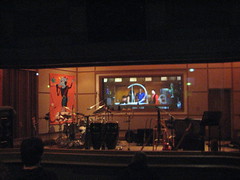 I hope the Imagineers didn’t have to stay up too late working on that one). 5), God, I hate Aerosmith, I didn’t even know anything about them before today, but after watching the same clip of the band members hanging out around the studio trying to get attention from their lead-whatever as he rattles on about how amazingly cool he is, I wish I could go back to that state of ignorance I had on the group before I came to Disney. However, the boarding platform is a decent setup, lots of lighting effects and clear viewing space to watch a train launch, which looks pretty fast with the strobe lights and everything. Best of all, as I mentioned they move the trains through with great rapidity and the queue attendant assigning seats assures every spot is filled and ready to go for the next dispatch while generally being easy on taking specific seat requests. I hope the Imagineers didn’t have to stay up too late working on that one). 5), God, I hate Aerosmith, I didn’t even know anything about them before today, but after watching the same clip of the band members hanging out around the studio trying to get attention from their lead-whatever as he rattles on about how amazingly cool he is, I wish I could go back to that state of ignorance I had on the group before I came to Disney. However, the boarding platform is a decent setup, lots of lighting effects and clear viewing space to watch a train launch, which looks pretty fast with the strobe lights and everything. Best of all, as I mentioned they move the trains through with great rapidity and the queue attendant assigning seats assures every spot is filled and ready to go for the next dispatch while generally being easy on taking specific seat requests.
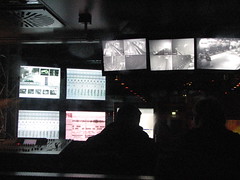 Loaded into the train we round the corner and wait for the launch. A countdown sequence with lighting effects, and then we’re off down the runway. The acceleration is neither as sudden nor as fast as it appeared from off-ride, and it seems quit halfway down the launch zone before we’ve reached full speed. Partly this is to accommodate a stretch of anti-rollback brakes at the end of the launch, but it also seems as though they’ve dialed it back from its full potential. Nevertheless the train surges up into the signature rollover element, which is hugely reminiscent of the opening element from Premier’s Flight of Fear spaghetti bowl layout, only without the third inversion, the intensity, or the lapbar-only trains. Still a good element, though. Afterward the train rises back up around a large right curve. And it keeps on turning right as swoops Loaded into the train we round the corner and wait for the launch. A countdown sequence with lighting effects, and then we’re off down the runway. The acceleration is neither as sudden nor as fast as it appeared from off-ride, and it seems quit halfway down the launch zone before we’ve reached full speed. Partly this is to accommodate a stretch of anti-rollback brakes at the end of the launch, but it also seems as though they’ve dialed it back from its full potential. Nevertheless the train surges up into the signature rollover element, which is hugely reminiscent of the opening element from Premier’s Flight of Fear spaghetti bowl layout, only without the third inversion, the intensity, or the lapbar-only trains. Still a good element, though. Afterward the train rises back up around a large right curve. And it keeps on turning right as swoops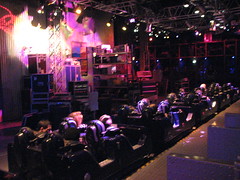 back down, and back up, and all the way to the first block brake. From here we start to turn left, and we keep on turning left, dipping up and down a little bit, until there is a corkscrew, which allows a change of direction so we exit it once again turning right. And we keep on curving around to the right until there is another brake run (and the transition from curve to flat is not even heartlined, the track just starts to level out along the last part of the curve causing some unexpected laterals. C’mon, Vekoma, you built this in 2002, this is stuff that Stengel and Schwarzkopf had figured out some twenty-five years earlier). After this brake run comes a real surprise… we go left! The train continues around a wide left turn, making some gentle carousel hops up and down, until it reaches a brake run whose length suggests it was designed back down, and back up, and all the way to the first block brake. From here we start to turn left, and we keep on turning left, dipping up and down a little bit, until there is a corkscrew, which allows a change of direction so we exit it once again turning right. And we keep on curving around to the right until there is another brake run (and the transition from curve to flat is not even heartlined, the track just starts to level out along the last part of the curve causing some unexpected laterals. C’mon, Vekoma, you built this in 2002, this is stuff that Stengel and Schwarzkopf had figured out some twenty-five years earlier). After this brake run comes a real surprise… we go left! The train continues around a wide left turn, making some gentle carousel hops up and down, until it reaches a brake run whose length suggests it was designed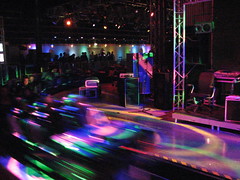 for a train entering it at some 70mph. for a train entering it at some 70mph.
Now that it’s over, I can only think, “Wow! Was that really… necessary?” It’s not an actively displeasurable experience, not really rough and only slightly uncomfortable where it starts to pull excessive lateral g-forces (and really, those are sort of the highlights of the ride), and the interior lighting and effects are decent, better than the disco balls in Crush’s Coaster at least. But there’s absolutely zero purpose to the layout at all, it’s as if the designers and Imagineers forgot what a coaster is supposed to do so they just filled it in with whatever was easiest to design effects around. The soundtrack adds extremely little, not quite able to overcome the sound of the train roaring around the track, it’s like someone just hooked up their iPod to the cars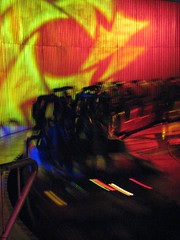 and made us listen to random Aerosmith tunes (the fact that the coaster has nothing for pace or progression would make it a challenge to sync any sort of music to help improve). It’s especially unnecessary in the light of already having Space Mountain next door, and the only reason I can fathom its existence is because they already had the blueprints from the original Florida version, and they needed to pull an E-Ticket attraction off the shelve to include in the new Studios Park so this is what they got landed with. I’m not begrudging this coaster’s existence, far from it as this and Tower were the only two things I bothered to get re-rides on all day, and in the case of Rock ‘n’ Roller Coaster that would mean many re-rides (with the short lines, on the order of some 15 or so rides before I was done with my days at Disney), but considering the amount of money this costs, I wish it could have been given to Cedar Fair or someone who could have taken it and made a coaster much more worth my while (and given my general feeling towards Cedar Fair’s creative skills, that’s a pretty low opinion). Makes me long for the days when I was riding the most cookie-cutter B&M sitdown layout imaginable, listening to Whole Lotta Love as we crested the top of the lift, and still thinking it was pretty great. and made us listen to random Aerosmith tunes (the fact that the coaster has nothing for pace or progression would make it a challenge to sync any sort of music to help improve). It’s especially unnecessary in the light of already having Space Mountain next door, and the only reason I can fathom its existence is because they already had the blueprints from the original Florida version, and they needed to pull an E-Ticket attraction off the shelve to include in the new Studios Park so this is what they got landed with. I’m not begrudging this coaster’s existence, far from it as this and Tower were the only two things I bothered to get re-rides on all day, and in the case of Rock ‘n’ Roller Coaster that would mean many re-rides (with the short lines, on the order of some 15 or so rides before I was done with my days at Disney), but considering the amount of money this costs, I wish it could have been given to Cedar Fair or someone who could have taken it and made a coaster much more worth my while (and given my general feeling towards Cedar Fair’s creative skills, that’s a pretty low opinion). Makes me long for the days when I was riding the most cookie-cutter B&M sitdown layout imaginable, listening to Whole Lotta Love as we crested the top of the lift, and still thinking it was pretty great.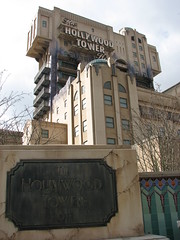
Around this time my fast pass for the Twilight Zone: Tower of Terror was ready, so I went over to grab another one (it and the Genie flat ride were the only rides in the entire park with flash pass access so I just kept on grabbing more Tower tickets and never once waited in the regular line). I think this won a poll some months ago for the best single attraction in the state of Florida, so needless to say I was curious to see why the high praise even though I was aware the Parisian version was slightly less adored than its Floridian cousin.
I’ll start off by saying: I can see the reason for the high praise. The attention to detail in the queue and preshow is great, the architecture great, the attendants great, the backstory… well, not so great. It seems like it has potential but the preshow television just shows people get on an elevator, elevator gets struck by lightning, then elevator plummets…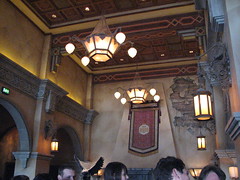 that’s not a Twilight Zone story, that’s a technical malfunction as an excuse to theme a drop tower ride (but wait, the people show up as ghosts for some arbitrary reason afterward). I thought the main selling point of a Disney attraction is that they were expert storytellers, why am I getting all these pedestrian narratives in every themed attraction that tries to tell a story? No matter, it’s more about the atmosphere anyway, and once we’re loaded into our elevator car is when things get interesting. that’s not a Twilight Zone story, that’s a technical malfunction as an excuse to theme a drop tower ride (but wait, the people show up as ghosts for some arbitrary reason afterward). I thought the main selling point of a Disney attraction is that they were expert storytellers, why am I getting all these pedestrian narratives in every themed attraction that tries to tell a story? No matter, it’s more about the atmosphere anyway, and once we’re loaded into our elevator car is when things get interesting.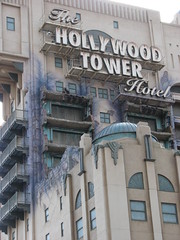 As the doors close, the car backs away from them, the lights going down and the scene appears to turn into a starry field. We’re taken up one level, the doors open, and we see a hotel waiting area, with a large mirror on the back wall reflecting the passengers. Suddenly there’s a flash of lightning, the light changes to reveal a ghostly version of the same scene, and the passenger’s reflections are now black and blue outlines. The doors close and we rise another level. They open, and the people we saw board the elevator in the preshow video are standing in a doorway. There’s an amazing effect where the hallway seems to stretch away from us, and then the walls all disappear to be replaced with a starry sky, the doorway still hovering on its own while it starts to twist away slightly. This effect really got my attention because as far as I could tell the set started off entirely with practical effects, but by the end they had clearly manipulated it in ways I can’t even begin to comprehend. The elevator rises once more, and then we drop. As the doors close, the car backs away from them, the lights going down and the scene appears to turn into a starry field. We’re taken up one level, the doors open, and we see a hotel waiting area, with a large mirror on the back wall reflecting the passengers. Suddenly there’s a flash of lightning, the light changes to reveal a ghostly version of the same scene, and the passenger’s reflections are now black and blue outlines. The doors close and we rise another level. They open, and the people we saw board the elevator in the preshow video are standing in a doorway. There’s an amazing effect where the hallway seems to stretch away from us, and then the walls all disappear to be replaced with a starry sky, the doorway still hovering on its own while it starts to twist away slightly. This effect really got my attention because as far as I could tell the set started off entirely with practical effects, but by the end they had clearly manipulated it in ways I can’t even begin to comprehend. The elevator rises once more, and then we drop.
 Did I say “drop”? I meant more like “bounce”. The car bounces us up and down several times as if on an oversized Frog Hopper, then pulls us back all the way to the top, where the doors open and we get to look out over the park and see Space Mountain off in the distance while the cameras take our picture, and then it bounces us down the shaft again, each time providing a fun boost of weightlessness, but by this point everyone is laughing instead of screaming. It repeats the cycle once more before returning us to the lower level, the star field returning as we re-approach the doors, the narration closing out the Twilight Zone theme (complete with the beatnik percussion) and the experience is over. Fun ride, but not in any way terrifying. Did I say “drop”? I meant more like “bounce”. The car bounces us up and down several times as if on an oversized Frog Hopper, then pulls us back all the way to the top, where the doors open and we get to look out over the park and see Space Mountain off in the distance while the cameras take our picture, and then it bounces us down the shaft again, each time providing a fun boost of weightlessness, but by this point everyone is laughing instead of screaming. It repeats the cycle once more before returning us to the lower level, the star field returning as we re-approach the doors, the narration closing out the Twilight Zone theme (complete with the beatnik percussion) and the experience is over. Fun ride, but not in any way terrifying.
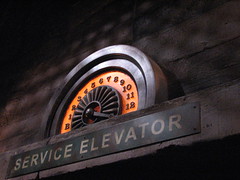 I was a bit let down in that regard. Sure, more families are going to ride this than if it were at other parks, but the main appeal I generally associate with these tower rides was the psychological suspense building up to the big drop, and both factors were mostly absent on Tower. I was particularly surprised by the lack of suspense, since it seemed like that was the one thing that the theme would most dramatically increase, but instead with the narrative whisking us away from one cool special effects scene to the next I found I forgot or didn’t care about any build-up to a big drop that was in my immediate future, and was just focused on what was going on right now. Then the drop does hit, and it’s only 20 feet deep before it pulls up to bounce us around some more, and by that point any lingering traces of tension I was a bit let down in that regard. Sure, more families are going to ride this than if it were at other parks, but the main appeal I generally associate with these tower rides was the psychological suspense building up to the big drop, and both factors were mostly absent on Tower. I was particularly surprised by the lack of suspense, since it seemed like that was the one thing that the theme would most dramatically increase, but instead with the narrative whisking us away from one cool special effects scene to the next I found I forgot or didn’t care about any build-up to a big drop that was in my immediate future, and was just focused on what was going on right now. Then the drop does hit, and it’s only 20 feet deep before it pulls up to bounce us around some more, and by that point any lingering traces of tension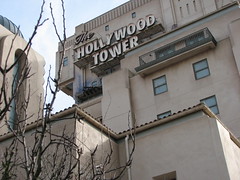 have all been dissolved. From the outside I noticed the doors that open when the cars are at the top of the tower are still a good 50 feet below the actual top of the tower, and I had to wonder why they didn’t use that extra vertical space they had built. It still gives a fun boost of air, but on re-rides the tension-building aspect was especially weak because I knew there was nothing to build tension for, I just had to enjoy the special effects on the way up and laugh at the fun bouncy drops on the way down, and that was as deep as any emotional reaction went. So I’ll reiterate those points: impressive technical skills and a fun ride cycle lead me to see why it’s earned some high praise, but as a full experience I personally felt like it did not live up to what I had been promised. I still did it about five times. have all been dissolved. From the outside I noticed the doors that open when the cars are at the top of the tower are still a good 50 feet below the actual top of the tower, and I had to wonder why they didn’t use that extra vertical space they had built. It still gives a fun boost of air, but on re-rides the tension-building aspect was especially weak because I knew there was nothing to build tension for, I just had to enjoy the special effects on the way up and laugh at the fun bouncy drops on the way down, and that was as deep as any emotional reaction went. So I’ll reiterate those points: impressive technical skills and a fun ride cycle lead me to see why it’s earned some high praise, but as a full experience I personally felt like it did not live up to what I had been promised. I still did it about five times.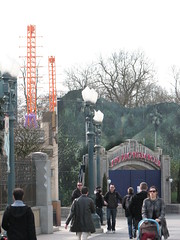
I’m sort of running out of rides to talk about, so I’ll briefly review some of the other ‘things’ I did at the Studios Park. I only had to drop down about €12 for lunch to get a croque-monsieur, bag of chips, soft drink and slice of cheesecake (what other options do I have, I’m trapped on an island where everything that doesn’t require a train ticket is owned by Disney…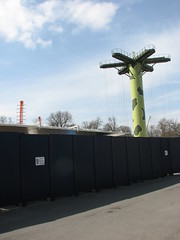 the worst part is that actually didn’t seem like that bad of a deal at the time!), and then I also had a quick look around at the construction site for Toy Story Playland. The Studio Tram Tours were unfortunately out of commission to accommodate the construction, but I think once it’s done the park will be another step closer to feeling more “complete”, with the Ratatouille dark ride on line afterward being one of the main things still missing to finally let the park live up to its full potential. What these attractions have to do with filmmaking, I don’t know, but that’s a limited theme for a park anyway and it needs whatever it can get. I’m curious though how they’re going to manage the queue for the R/C Racer Intamin Halfpipe coaster, since they seem to be even lower capacity rides than the Crush’s Coaster. I thought I saw on a blue-print that there would be two tracks side-by-side, but I could only see one completed track while I was there. the worst part is that actually didn’t seem like that bad of a deal at the time!), and then I also had a quick look around at the construction site for Toy Story Playland. The Studio Tram Tours were unfortunately out of commission to accommodate the construction, but I think once it’s done the park will be another step closer to feeling more “complete”, with the Ratatouille dark ride on line afterward being one of the main things still missing to finally let the park live up to its full potential. What these attractions have to do with filmmaking, I don’t know, but that’s a limited theme for a park anyway and it needs whatever it can get. I’m curious though how they’re going to manage the queue for the R/C Racer Intamin Halfpipe coaster, since they seem to be even lower capacity rides than the Crush’s Coaster. I thought I saw on a blue-print that there would be two tracks side-by-side, but I could only see one completed track while I was there.
The Art of Disney Animation begins with a preshow lobby room filled with displays of varying historical value such as a zoetrope and other such devices, while clips from the earliest years of Disney animation play against a wall. We’re then led into a movie theater which gives us a ten minute show demonstrating the Art of Disney Montage, with clips from numerous Disney and Pixar films assembled together in a way meant to arouse the same emotions felt from our favorite movies but instead reveal just how much Disney has a tendency recycle the same plot and character devices. That’s not even to rag on Disney too much since there’s probably a lot of depth that could be analyzed from that basic story structure Disney uses time and time again that would explain precisely why it doesn’t lose its affect after multiple viewings, or even for that matter why it needs to be reinterpreted into different stories. From there the main part of the show in the next room was a mix of a live action performance with projected screens. The performance was in French so I had to wear headphone giving the English version (which took away from the fact that it was being acted out live).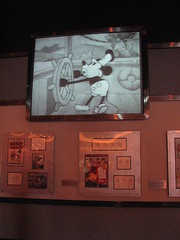 There actually was some insight into the creative process, in this case specifically, designing the character Mushu in Mulan. I don’t think I would have missed much if I just heard the live French version. There actually was some insight into the creative process, in this case specifically, designing the character Mushu in Mulan. I don’t think I would have missed much if I just heard the live French version.
Scattered between more Tower of Terror and Rock ‘n’ Roller Coaster rides, I eventually found I ran out of time in my day and had time for only one more new attraction. Originally I wanted to make it another ride on Crush’s Coaster but that would have eliminated all the time I had left in the day, so I decided to make it something I hadn’t done yet and caught the last screening of CinéMagique. I have no idea what audience this was intended for. For one, you have to be bilingual to understand everything that’s going on because there are no subtitles in English for the sections in French, nor French subtitles for those sections in English. It’s mostly in English however, which made me at times wonder if this had originally been made for the Florida or California parks until a French section came in reminding me it was clearly filmed just for the Studios Park in Paris. It’s mostly just a half-hour long movie sitting in a giant theater, but they incorporate some physical effects  (the first time it happened I was really surprised until I figured out what was going on… I won’t give it away for those that might be seeing it for themselves). Once again, the art of montage is on full display, only this time with live-action movies that span the history of cinema, and starring Martin Short as he stumbles around from one famous movie scene to the next, his comedic skills on display here consist almost entirely of grinning at the camera. The films represented range from all over (Charlie Chaplin, a scene that’s a mix of footage from the Good, the Bad and the Ugly with Once Upon A Time in the West, Star Wars, Titanic, Monty Python and the Holy Grail, Casablanca, Some Like It Hot, Mary Poppins, The Full Monty, Pinocchio, The Pink Panther, The Exorcist, The Silence of the Lambs, and more. Again, this attraction seems better marketed for English speakers than French, as not one of the films reference shows anything to do with French cinematic history, which is considerable and yet completely neglected by Disney. Although as I finish writing this I’m hearing the harmonica theme from Once Upon a Time in the West play in my head which makes me want to watch it again, so I at least got that benefit. (the first time it happened I was really surprised until I figured out what was going on… I won’t give it away for those that might be seeing it for themselves). Once again, the art of montage is on full display, only this time with live-action movies that span the history of cinema, and starring Martin Short as he stumbles around from one famous movie scene to the next, his comedic skills on display here consist almost entirely of grinning at the camera. The films represented range from all over (Charlie Chaplin, a scene that’s a mix of footage from the Good, the Bad and the Ugly with Once Upon A Time in the West, Star Wars, Titanic, Monty Python and the Holy Grail, Casablanca, Some Like It Hot, Mary Poppins, The Full Monty, Pinocchio, The Pink Panther, The Exorcist, The Silence of the Lambs, and more. Again, this attraction seems better marketed for English speakers than French, as not one of the films reference shows anything to do with French cinematic history, which is considerable and yet completely neglected by Disney. Although as I finish writing this I’m hearing the harmonica theme from Once Upon a Time in the West play in my head which makes me want to watch it again, so I at least got that benefit.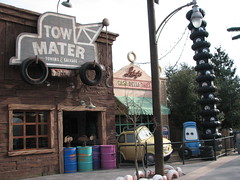
I’m going to cheat a little bit since that was my last ride of the day at the Studios Park, but afterward I went over to Disneyland since they were open an hour later and got a few more Space Mountain rides in. The next day, since I still felt like I hadn’t seen everything I needed to see at the Studios Park, I made that the first stop of the day up until noon, where I got a couple more attractions I missed on the first. First of all, I made sure to really get there at park opening this time, and I got to be one of the first in line for my second ride on Crush’s Coaster… there was still a half hour wait until they would open the ride for us, by which time a full queue had formed behind me making an immediate re-ride impossible. But I did get to catch the Cars Quatre Roues Rallye, a Zamperla 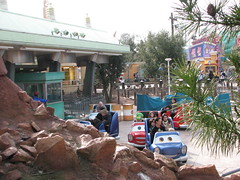 Demolition Derby that basically replicates the motions of any normal spinning flat ride, but with the unique exception of that the cars run on a figure-eight track. I’m not sure exactly how the technology works that allows them to make the switchover in the middle of the figure- eight, but it results in a chaotic scene with some extremely narrow calls as the cars dive between each other’s paths. Good ride, although the low capacity probably hurts it on busier operating days. A video clip I took on board the ride can be watched here. Demolition Derby that basically replicates the motions of any normal spinning flat ride, but with the unique exception of that the cars run on a figure-eight track. I’m not sure exactly how the technology works that allows them to make the switchover in the middle of the figure- eight, but it results in a chaotic scene with some extremely narrow calls as the cars dive between each other’s paths. Good ride, although the low capacity probably hurts it on busier operating days. A video clip I took on board the ride can be watched here.
Between a few more Rock ‘n’ Roller Coaster rides I finally managed to get Armageddon – Les Effets Speciaux, which I had tried to do the previous day but the first time the queue attendant decided the people ahead of me would be the last people let into the next show and turned me away (literally, told me to get out of the queue altogether), and the second time after joining the mostly full waiting area for some five minutes, was told it was going to be another fifteen minutes until we were let in, at which point I realized my schedule was already far enough behind from the Crush’s Coaster wait and the delay in starting the stunt car show that I decided to bail. So I finally got to do it on the third attempt and while it most likely wasn’t worth it there wasn’t anything else better to do with my time. After a preshow explaining how we’re filming a scene for the movie Armageddon (Really? Michael Bay is the best IP they find for this? I’ve said this several times already but I’m in France, why do I have to deal with this sort of crap all the way over here?) we’re led into a space-ship themed special effects chamber that supposedly undergoes a meteor barrage. into the next show and turned me away (literally, told me to get out of the queue altogether), and the second time after joining the mostly full waiting area for some five minutes, was told it was going to be another fifteen minutes until we were let in, at which point I realized my schedule was already far enough behind from the Crush’s Coaster wait and the delay in starting the stunt car show that I decided to bail. So I finally got to do it on the third attempt and while it most likely wasn’t worth it there wasn’t anything else better to do with my time. After a preshow explaining how we’re filming a scene for the movie Armageddon (Really? Michael Bay is the best IP they find for this? I’ve said this several times already but I’m in France, why do I have to deal with this sort of crap all the way over here?) we’re led into a space-ship themed special effects chamber that supposedly undergoes a meteor barrage. There are numerous lights and bursts of fog and rocking floors and the occasional pyrotechnics, culminating in a huge fireball that erupts twice in the center of the room (which I was in very close proximity to and got doused by the water sprinklers meant to control it, thank you very much for asking). Of course everyone cheers and we’re funneled back out the exit. I grab one last ride on Tower of Terror and then move on to finish the rest of the day at Disneyland Park. There are numerous lights and bursts of fog and rocking floors and the occasional pyrotechnics, culminating in a huge fireball that erupts twice in the center of the room (which I was in very close proximity to and got doused by the water sprinklers meant to control it, thank you very much for asking). Of course everyone cheers and we’re funneled back out the exit. I grab one last ride on Tower of Terror and then move on to finish the rest of the day at Disneyland Park.
|
|
 park in Orlando, Michael Eisner quickly scrambled together a press conference to announce his own plans for a third gate at Walt Disney World, which looked suspiciously identical to the proposed movie theme from their soon-to-be competitors. Using some ride concepts from unused proposals for their existing parks, Disney-MGM Studios managed to complete a year ahead of Universal Studios despite the later construction start, partly thanks to the Disney Company’s special jurisdiction in Florida that lets them issue their own construction permits. Upon opening their gates, visitors to Disney-MGM Studios were treated to a grand total of four different attractions to fill out their day of adventure, as well as a separate movie production studio which gave us such classics as Ernest Saves Christmas and Thunder in Paradise before it was eventually downsized back to California… not that that fact should be any reason they can’t still pretend that we get to watch real movies and television be made.
park in Orlando, Michael Eisner quickly scrambled together a press conference to announce his own plans for a third gate at Walt Disney World, which looked suspiciously identical to the proposed movie theme from their soon-to-be competitors. Using some ride concepts from unused proposals for their existing parks, Disney-MGM Studios managed to complete a year ahead of Universal Studios despite the later construction start, partly thanks to the Disney Company’s special jurisdiction in Florida that lets them issue their own construction permits. Upon opening their gates, visitors to Disney-MGM Studios were treated to a grand total of four different attractions to fill out their day of adventure, as well as a separate movie production studio which gave us such classics as Ernest Saves Christmas and Thunder in Paradise before it was eventually downsized back to California… not that that fact should be any reason they can’t still pretend that we get to watch real movies and television be made. as the smallest of three (now four) gates the motivation for Disney’s Studios park to compete would never be as great as Universal’s focus of resources would be on their flagship property. The similarities and differences between the two parks today are telling. Both promised a peek behind the scenes of moviemaking even though both have ill-fated histories of actual movie production in Florida, and both have relatively uninspiring visual identities, simulating soundstages and movie sets that even if real wouldn’t have much innate aesthetic appeal anyway.1 Both parks also tend to be treated as the dumping grounds for intellectual properties their parent companies want to build a ride out of but wouldn’t quite fit behind their other more thematically structured gates.
as the smallest of three (now four) gates the motivation for Disney’s Studios park to compete would never be as great as Universal’s focus of resources would be on their flagship property. The similarities and differences between the two parks today are telling. Both promised a peek behind the scenes of moviemaking even though both have ill-fated histories of actual movie production in Florida, and both have relatively uninspiring visual identities, simulating soundstages and movie sets that even if real wouldn’t have much innate aesthetic appeal anyway.1 Both parks also tend to be treated as the dumping grounds for intellectual properties their parent companies want to build a ride out of but wouldn’t quite fit behind their other more thematically structured gates. of more even quality, which has left many of the original themed environments still cohesively intact. There are more pathways and buildings around Hollywood Studios that are pleasurable to simply explore or admire the historical references at one’s own leisure (e.g. Sunset Blvd., Echo Lake), whereas Universal Studios emphasizes action with design choices intended to funnel us into the queue of the nearest attraction. Perpetually compared to the other three theme parks on Walt Disney World’s property, it can be easy to forget that if on its own Disney’s Hollywood Studios would still be a relatively beautiful park when inspected up close.
of more even quality, which has left many of the original themed environments still cohesively intact. There are more pathways and buildings around Hollywood Studios that are pleasurable to simply explore or admire the historical references at one’s own leisure (e.g. Sunset Blvd., Echo Lake), whereas Universal Studios emphasizes action with design choices intended to funnel us into the queue of the nearest attraction. Perpetually compared to the other three theme parks on Walt Disney World’s property, it can be easy to forget that if on its own Disney’s Hollywood Studios would still be a relatively beautiful park when inspected up close. by contrast is both narrow in concept and narcissistic in delivery. It’s a vanity project designed primarily to please the old guard of Hollywood executives who built it in the first place. A place to reminisce over how easy it used to be to deceive audiences with either a little glitz and glamour on the red carpet or some make-up and special effects on the silver screen, while assuming that modern audiences still share that same nostalgic desire to be duped by these manufactured illusions of the culture industry.2 The phrase “you ought to be in pictures” is glimpsed several times to remind us that the ability to make it into Hollywood should still be considered the highest endorsement of an individual’s beauty and self-worth, even if most people today would interpret such a sentiment as cutely quaint rather than truly honorary. Therefore it’s perhaps of interest to note that two of the most original attractions, The Twilight Zone Tower of Terror and Muppet*Vision 3D, are both to some degree deconstructions of the vainglorious attitudes towards movie magic that define the rest of this theme park.
by contrast is both narrow in concept and narcissistic in delivery. It’s a vanity project designed primarily to please the old guard of Hollywood executives who built it in the first place. A place to reminisce over how easy it used to be to deceive audiences with either a little glitz and glamour on the red carpet or some make-up and special effects on the silver screen, while assuming that modern audiences still share that same nostalgic desire to be duped by these manufactured illusions of the culture industry.2 The phrase “you ought to be in pictures” is glimpsed several times to remind us that the ability to make it into Hollywood should still be considered the highest endorsement of an individual’s beauty and self-worth, even if most people today would interpret such a sentiment as cutely quaint rather than truly honorary. Therefore it’s perhaps of interest to note that two of the most original attractions, The Twilight Zone Tower of Terror and Muppet*Vision 3D, are both to some degree deconstructions of the vainglorious attitudes towards movie magic that define the rest of this theme park. All told Disney’s Hollywood Studios is still a worthwhile entry amongst Central Florida’s theme park selection, if not only because it has a collection of attractions with greater appeal to most ride enthusiasts than the average Disney park. Perhaps what it needs more than anything else could be as simple as a proper central icon instead of the Sorcerer’s Hat placed there “temporarily” since 2001. Something that could give the complete park a more unified, universal message, instead of a slapdash icon reminding us of the park’s slapdash heritage built by competing corporate egos with evidently very little imagination left in the world.
All told Disney’s Hollywood Studios is still a worthwhile entry amongst Central Florida’s theme park selection, if not only because it has a collection of attractions with greater appeal to most ride enthusiasts than the average Disney park. Perhaps what it needs more than anything else could be as simple as a proper central icon instead of the Sorcerer’s Hat placed there “temporarily” since 2001. Something that could give the complete park a more unified, universal message, instead of a slapdash icon reminding us of the park’s slapdash heritage built by competing corporate egos with evidently very little imagination left in the world. Here’s a dark ride built by geeks for geeks. At first the uninspired descriptive title and central placement as Hollywood Studio’s “mascot” attraction (à la Cinderella Castle or Spaceship Earth, this time with Mann’s Chinese Theatre) made me fear this could be a very vanilla work of Hollywood pageantry, overproduced as only Disney knows how. Thankfully that’s not (entirely) the case, as the show producers seem to demonstrate a genuine giddy enthusiasm for toying with many conventions of theme park attractions while simultaneously flattering our pop-culture savvy. Like, “wouldn’t-it-be-cool-if-the-ride-host-gets-kidnapped-by-a-villain-from-a-gangster-flick-or-spaghetti-western”, and “wouldn’t-it-be-cooler-if-then-the-gangster-gets-owned-by-the-xenomorph-from-Alien”, but then “wouldn’t-it-be-coolest-if-he-gets-his-
Here’s a dark ride built by geeks for geeks. At first the uninspired descriptive title and central placement as Hollywood Studio’s “mascot” attraction (à la Cinderella Castle or Spaceship Earth, this time with Mann’s Chinese Theatre) made me fear this could be a very vanilla work of Hollywood pageantry, overproduced as only Disney knows how. Thankfully that’s not (entirely) the case, as the show producers seem to demonstrate a genuine giddy enthusiasm for toying with many conventions of theme park attractions while simultaneously flattering our pop-culture savvy. Like, “wouldn’t-it-be-cool-if-the-ride-host-gets-kidnapped-by-a-villain-from-a-gangster-flick-or-spaghetti-western”, and “wouldn’t-it-be-cooler-if-then-the-gangster-gets-owned-by-the-xenomorph-from-Alien”, but then “wouldn’t-it-be-coolest-if-he-gets-his- face-melted-like-the-guy-in-Indiana-Jones-and-the-guardian-of-the-Ark-of-the-Covenant-turns-out-is-the-original-ride-host-in-disguise”? (Deep breath.) Given how many different ideas the Imagineers tried to cram together The Great Movie Ride easily could have suffered from over complication, but… well, okay, it is a little over complicated. Sure that’s part of the charm, but mixing live performers with audio-animatronics on the same stage almost always produces extra awkward results, and the script’s handful of “spontaneous surprises” often play stale or forced, simply due to the nature of a theme park attraction that requires casts members to read the same lines every twenty minutes every day for the rest of their career. The Great Movie Ride wants us to admire its cleverness and craftsmanship, but it’s mostly just an expensive work of fan fiction; an emotional parasite
face-melted-like-the-guy-in-Indiana-Jones-and-the-guardian-of-the-Ark-of-the-Covenant-turns-out-is-the-original-ride-host-in-disguise”? (Deep breath.) Given how many different ideas the Imagineers tried to cram together The Great Movie Ride easily could have suffered from over complication, but… well, okay, it is a little over complicated. Sure that’s part of the charm, but mixing live performers with audio-animatronics on the same stage almost always produces extra awkward results, and the script’s handful of “spontaneous surprises” often play stale or forced, simply due to the nature of a theme park attraction that requires casts members to read the same lines every twenty minutes every day for the rest of their career. The Great Movie Ride wants us to admire its cleverness and craftsmanship, but it’s mostly just an expensive work of fan fiction; an emotional parasite that survives by feeding off superior works of art. Sure the satisfaction of winning a game of “Spot the Movie References” can be real, it’s just also not very deep.
that survives by feeding off superior works of art. Sure the satisfaction of winning a game of “Spot the Movie References” can be real, it’s just also not very deep. of the confederate’s presence allows for some amusing did-that-really-just-happen gags. When the set culminates in an outrageous stunt that instantly clues everyone into the act, the show wisely doesn’t try to stretch our disbelief any further and immediately acknowledges the ruse so that everyone can authentically cheer a fine performance (one most didn’t even realize was a performance twenty seconds earlier). Well played, and enjoyable entertainment. Given that the majority of the Indiana Jones Epic Stunt Spectacular doesn’t try to be a work of theater but just an honest demonstration of the physical stunts and special effects that make movie magic, it’s therefore more conspicuously odd when the show writers do try to enforce an obviously fictional conceit. The worst offender is the repeated claims to convince us this set is actually used
of the confederate’s presence allows for some amusing did-that-really-just-happen gags. When the set culminates in an outrageous stunt that instantly clues everyone into the act, the show wisely doesn’t try to stretch our disbelief any further and immediately acknowledges the ruse so that everyone can authentically cheer a fine performance (one most didn’t even realize was a performance twenty seconds earlier). Well played, and enjoyable entertainment. Given that the majority of the Indiana Jones Epic Stunt Spectacular doesn’t try to be a work of theater but just an honest demonstration of the physical stunts and special effects that make movie magic, it’s therefore more conspicuously odd when the show writers do try to enforce an obviously fictional conceit. The worst offender is the repeated claims to convince us this set is actually used for filming movies, as if studio films are produced with live studio audiences and being a Harrison Ford stunt double for the Indiana Jones franchise is a steady career with regular 9-5 working hours, ideal for the muscular 20-something theater grads they’ve hired. Maybe this premise worked for one year in 1989 when this show first debuted and the Last Crusade opened in theaters featuring a still youthful Mr. Ford, but today it’s just a distracting reminder of how Disney can’t be bothered to update even a few lines of script for a live performance in over twenty years. It also suggests the writers don’t have confidence to let their show stand on its own merits; don’t worry, no one will be disappointed to learn that your theme park stunt show isn’t real and is really only there to entertain audiences in a theme park with stunts.
for filming movies, as if studio films are produced with live studio audiences and being a Harrison Ford stunt double for the Indiana Jones franchise is a steady career with regular 9-5 working hours, ideal for the muscular 20-something theater grads they’ve hired. Maybe this premise worked for one year in 1989 when this show first debuted and the Last Crusade opened in theaters featuring a still youthful Mr. Ford, but today it’s just a distracting reminder of how Disney can’t be bothered to update even a few lines of script for a live performance in over twenty years. It also suggests the writers don’t have confidence to let their show stand on its own merits; don’t worry, no one will be disappointed to learn that your theme park stunt show isn’t real and is really only there to entertain audiences in a theme park with stunts.
 revamped Star Tours, which touts an impressive 54 different film sequences for a new adventure each time, could easily become something of a curse for a completionist prone to motion sickness such as myself. Still, with the aid of Dramamine and FastPasses I managed a total of four rides before having to call it quits, and that was more because of my annoyance that my fourth ride consisted of segments I had already seen at least twice while a handful of possible scenes continued to elude me. As an experiential short film set in the Star Wars universe there’s no doubt that Star Tours is tremendously successful at what it does, and the randomized sequences to encourage multiple re-rides is a long overdue idea to extract more value for repeat visitors at a lower marginal expense to the designers,3 even though there’s really only three
revamped Star Tours, which touts an impressive 54 different film sequences for a new adventure each time, could easily become something of a curse for a completionist prone to motion sickness such as myself. Still, with the aid of Dramamine and FastPasses I managed a total of four rides before having to call it quits, and that was more because of my annoyance that my fourth ride consisted of segments I had already seen at least twice while a handful of possible scenes continued to elude me. As an experiential short film set in the Star Wars universe there’s no doubt that Star Tours is tremendously successful at what it does, and the randomized sequences to encourage multiple re-rides is a long overdue idea to extract more value for repeat visitors at a lower marginal expense to the designers,3 even though there’s really only three different sequences of significance that can be randomly rearranged in four spots like a Twist-and-Match toy figurine. For anyone who hasn’t already sworn allegiance to the Rebel Alliance before boarding their StarSpeeder, they may find that this lottery ball approach to storytelling shares a lot of the same narrative deficiencies as any other “Choose Your Own Adventure” story… and here you don’t even have the freedom to choose. Instead of 54 equally interchangeable riffs on the same concept, wouldn’t we have been better off choosing between three complete and completely different story arcs?
different sequences of significance that can be randomly rearranged in four spots like a Twist-and-Match toy figurine. For anyone who hasn’t already sworn allegiance to the Rebel Alliance before boarding their StarSpeeder, they may find that this lottery ball approach to storytelling shares a lot of the same narrative deficiencies as any other “Choose Your Own Adventure” story… and here you don’t even have the freedom to choose. Instead of 54 equally interchangeable riffs on the same concept, wouldn’t we have been better off choosing between three complete and completely different story arcs? an audience reaction by reaching through the screen for no reason related to the story; the artificiality of “lifelike” audio-animatronics who are in fact bolted in place and thus can never, ahem, relieve themselves between shows; and most hilariously, a parody/veiled critique of Epcot’s World Showcase in the form of Sam the Eagle’s patriotic final act titled “A Salute to All Nations, But Mostly America”. While sometimes the manic energy starts to run around in circles with no objective in sight, the only real downside of Muppet*Vision 3D that would cause hesitation over a second viewing is an interminable preshow that keeps everyone on their feet for much longer than seems necessary. Otherwise this is possibly the best 3D movie attraction currently playing at a major theme park.
an audience reaction by reaching through the screen for no reason related to the story; the artificiality of “lifelike” audio-animatronics who are in fact bolted in place and thus can never, ahem, relieve themselves between shows; and most hilariously, a parody/veiled critique of Epcot’s World Showcase in the form of Sam the Eagle’s patriotic final act titled “A Salute to All Nations, But Mostly America”. While sometimes the manic energy starts to run around in circles with no objective in sight, the only real downside of Muppet*Vision 3D that would cause hesitation over a second viewing is an interminable preshow that keeps everyone on their feet for much longer than seems necessary. Otherwise this is possibly the best 3D movie attraction currently playing at a major theme park. or the way vehicles suddenly yank and spin you from one level to the next imbuing the game with a physical sense of urgency… it’s impossible to make this formula more entertaining without controlled substances. And I’m not being (completely) sarcastic. Ride it once for what will seem like the second-best four minutes of your life so you’ll never have to bother again. Beware, the line fills up fast, so get a FastPass early in the day and do it quick before Mr. Potato Head has another aneurysm.
or the way vehicles suddenly yank and spin you from one level to the next imbuing the game with a physical sense of urgency… it’s impossible to make this formula more entertaining without controlled substances. And I’m not being (completely) sarcastic. Ride it once for what will seem like the second-best four minutes of your life so you’ll never have to bother again. Beware, the line fills up fast, so get a FastPass early in the day and do it quick before Mr. Potato Head has another aneurysm. This indoor complex houses several different attractions, including a show about animated character development, costumed character meet-and-greets (there are always meet-and-greets at Disney parks, and they often command some of the longest lines), interactive games, and a museum of Disney animation artwork. The combination live/projected show actually does offer some worthwhile insights into Disney’s creative process, even if the show writers seemed to lack confidence over the audience’s sustained interest in this material by overstuffing the script with throwaway gags. The interactive activities on the main floor are fairly unremarkable, not helped by the recent proliferation of the App marketplace that now makes large computer kiosks housing mini-games such as these almost entirely redundant.
This indoor complex houses several different attractions, including a show about animated character development, costumed character meet-and-greets (there are always meet-and-greets at Disney parks, and they often command some of the longest lines), interactive games, and a museum of Disney animation artwork. The combination live/projected show actually does offer some worthwhile insights into Disney’s creative process, even if the show writers seemed to lack confidence over the audience’s sustained interest in this material by overstuffing the script with throwaway gags. The interactive activities on the main floor are fairly unremarkable, not helped by the recent proliferation of the App marketplace that now makes large computer kiosks housing mini-games such as these almost entirely redundant. It’s cute that a program script can determine after six short questions that if I were a Disney character I would be Jafar from Aladdin (I couldn’t disagree), but in this decade do I really still need to travel to Florida for that information? The adjoining museum about Disney animation is perhaps the most worthwhile, even if (and perhaps this is simply due to the nature of animation) the exhibits are very two-dimensional and the experience is akin to a coffee table book you have to read while standing. Nevertheless I walked away with some newfound appreciation for the artwork in a number of classic and recent animated films I hadn’t previously given as much consideration to, which seems like a solid signal that this gallery must be a success.4
It’s cute that a program script can determine after six short questions that if I were a Disney character I would be Jafar from Aladdin (I couldn’t disagree), but in this decade do I really still need to travel to Florida for that information? The adjoining museum about Disney animation is perhaps the most worthwhile, even if (and perhaps this is simply due to the nature of animation) the exhibits are very two-dimensional and the experience is akin to a coffee table book you have to read while standing. Nevertheless I walked away with some newfound appreciation for the artwork in a number of classic and recent animated films I hadn’t previously given as much consideration to, which seems like a solid signal that this gallery must be a success.4 vehicles gliding gently past a fixed series of scenes could be translated into a different visual story medium without significant compromise, whereas a plot in which the audience must personally experience a zero-gravity freefall down an elevator shaft could not be replicated anywhere outside the theme park medium.5 The story, culled from an episode of the Twilight Zone, offers a breathtaking impression of Hollywood’s Golden Age as a source of simultaneous beauty and moral decay, cursed by the specter of time as familiar objects (including our own faces) phase in and out of the stardust from whence we came. In no other work of fiction has the existential dread rising from the pit of our stomach been felt so literally.
vehicles gliding gently past a fixed series of scenes could be translated into a different visual story medium without significant compromise, whereas a plot in which the audience must personally experience a zero-gravity freefall down an elevator shaft could not be replicated anywhere outside the theme park medium.5 The story, culled from an episode of the Twilight Zone, offers a breathtaking impression of Hollywood’s Golden Age as a source of simultaneous beauty and moral decay, cursed by the specter of time as familiar objects (including our own faces) phase in and out of the stardust from whence we came. In no other work of fiction has the existential dread rising from the pit of our stomach been felt so literally. argument for the story-ride fusion as a unique artistic medium, I’m frustrated by certain aspects that weaken this position. There are hints of intriguing ideas that could form the bedrock of a great popular science fiction story; e.g. Hollywood’s downfall reinterpreted as a modern Icarus myth featuring an iconic tower that reached for the sun only to fall when it got too close, or the notion that the familiar world is an illusory construct of ancient metaphysical entities. However there’s also a sense that any deeper interpretations are mere thematic ghosts left behind from the television show, and discussion over the story’s meaning would be more relevant to the source material than the watered-down remix in the attraction. Most of the narrative details are isolated to the corner of a dark room where a sixteen inch television screen6 quickly answers
argument for the story-ride fusion as a unique artistic medium, I’m frustrated by certain aspects that weaken this position. There are hints of intriguing ideas that could form the bedrock of a great popular science fiction story; e.g. Hollywood’s downfall reinterpreted as a modern Icarus myth featuring an iconic tower that reached for the sun only to fall when it got too close, or the notion that the familiar world is an illusory construct of ancient metaphysical entities. However there’s also a sense that any deeper interpretations are mere thematic ghosts left behind from the television show, and discussion over the story’s meaning would be more relevant to the source material than the watered-down remix in the attraction. Most of the narrative details are isolated to the corner of a dark room where a sixteen inch television screen6 quickly answers the perfunctory Who-What-Where-When bullet points from the storyteller’s manual while leaving the more interesting questions of How and Why largely unanswered. Perhaps this could be seen as a minimalist approach to story intended to foster suspense and encourage visitors to reach their own conclusions, but more realistically this brief and overly-expository video suggests that engagement with such questions was never intended in the first place. As long as the preshow provides adequate justification for the falling elevator concept and finishes with an eerie feeling of mystery, it matters not if the story has any deeper independent meaning. In this case “story” or “theme” becomes a means to an end: it’s window dressing there for those who would admire it the same way as they will distantly admire the set design or special effects,
the perfunctory Who-What-Where-When bullet points from the storyteller’s manual while leaving the more interesting questions of How and Why largely unanswered. Perhaps this could be seen as a minimalist approach to story intended to foster suspense and encourage visitors to reach their own conclusions, but more realistically this brief and overly-expository video suggests that engagement with such questions was never intended in the first place. As long as the preshow provides adequate justification for the falling elevator concept and finishes with an eerie feeling of mystery, it matters not if the story has any deeper independent meaning. In this case “story” or “theme” becomes a means to an end: it’s window dressing there for those who would admire it the same way as they will distantly admire the set design or special effects, and for everyone else it’s an excuse to put a drop tower ride in a Disney park. Given that the majority of people will exit chattering excitedly over what the ride did rather than what the ride was about, I can’t help but feel that for all Tower of Terror does right, the formula to make theme park attractions a “story-first” medium has yet to find the perfect balance.
and for everyone else it’s an excuse to put a drop tower ride in a Disney park. Given that the majority of people will exit chattering excitedly over what the ride did rather than what the ride was about, I can’t help but feel that for all Tower of Terror does right, the formula to make theme park attractions a “story-first” medium has yet to find the perfect balance. Okay Disney, we get it: you can be just as much of a badass as Universal Studios. The regrettably short-lived Hard Rock Park still beat both of your attempts at rock idolatry, as that property was created by people who evidenced a true love for the music unlike these poseurs sitting at the cool kid’s table in central Florida. So, Rock ‘n’ Roller Coaster is actually a pretty good Disney attraction while simultaneously being a pretty mediocre roller coaster.7 The show portion of the attraction (i.e. everything built by Imagineers) is simultaneously very “counter-Disney” while also extremely “classic Disney”, and I respect the balancing act needed to make this original concept (at the time) work. The visual aesthetic, which transitions from an ultra-modernist recording studio (the attraction’s “cover art”, as it were) to a dark and grungy backstage area
Okay Disney, we get it: you can be just as much of a badass as Universal Studios. The regrettably short-lived Hard Rock Park still beat both of your attempts at rock idolatry, as that property was created by people who evidenced a true love for the music unlike these poseurs sitting at the cool kid’s table in central Florida. So, Rock ‘n’ Roller Coaster is actually a pretty good Disney attraction while simultaneously being a pretty mediocre roller coaster.7 The show portion of the attraction (i.e. everything built by Imagineers) is simultaneously very “counter-Disney” while also extremely “classic Disney”, and I respect the balancing act needed to make this original concept (at the time) work. The visual aesthetic, which transitions from an ultra-modernist recording studio (the attraction’s “cover art”, as it were) to a dark and grungy backstage area (where the heart of rock ‘n’ roll is found), are both quite different from anything else found on Walt Disney World property with its traditional focus on reassuring fantasies and nostalgia. Yet the Rock ‘n’ Roller Coaster is hardly antiestablishment, as most of the traditions of Disney design are still present underneath it all; from the series of enchanted portals that gradually take us someplace removed from the everyday, to the abundant nostalgia that comforts us like a friendly hug… only this time for a generation that cherishes memorabilia from The Doors or Jimi Hendrix Experience rather than the typical 1950’s cultural iconography of other Disney parks. Unfortunately the coaster portion of the attraction (i.e. everything built by Vekoma) is also pretty last generational as well. Predictably there’s no sense of how to pace a layout so it’s exciting
(where the heart of rock ‘n’ roll is found), are both quite different from anything else found on Walt Disney World property with its traditional focus on reassuring fantasies and nostalgia. Yet the Rock ‘n’ Roller Coaster is hardly antiestablishment, as most of the traditions of Disney design are still present underneath it all; from the series of enchanted portals that gradually take us someplace removed from the everyday, to the abundant nostalgia that comforts us like a friendly hug… only this time for a generation that cherishes memorabilia from The Doors or Jimi Hendrix Experience rather than the typical 1950’s cultural iconography of other Disney parks. Unfortunately the coaster portion of the attraction (i.e. everything built by Vekoma) is also pretty last generational as well. Predictably there’s no sense of how to pace a layout so it’s exciting to the very end. The launch is cool (the use of lighting makes it look much faster than it really is, about twice as strong as a commercial airliner takeoff) and it immediately pours into the signature double rollover maneuver. After that the bulky limo-train lumbers around a series of flat geometric curves and block brakes with a lone corkscrew making a cameo appearance at some arbitrary midpoint. Basically a rip-off of the Premier-built Flight of Fear coasters that opened three years prior, lacking are the nimble directional changes, strategic lulls and crescendos, and final corkscrew that forcefully informs you of the finish. Of course the coaster component isn’t all that matters, but given that Disney thought it mattered enough to break the diegetic construct and put “Roller Coaster” in the very title, I don’t feel out of line asking for better.
to the very end. The launch is cool (the use of lighting makes it look much faster than it really is, about twice as strong as a commercial airliner takeoff) and it immediately pours into the signature double rollover maneuver. After that the bulky limo-train lumbers around a series of flat geometric curves and block brakes with a lone corkscrew making a cameo appearance at some arbitrary midpoint. Basically a rip-off of the Premier-built Flight of Fear coasters that opened three years prior, lacking are the nimble directional changes, strategic lulls and crescendos, and final corkscrew that forcefully informs you of the finish. Of course the coaster component isn’t all that matters, but given that Disney thought it mattered enough to break the diegetic construct and put “Roller Coaster” in the very title, I don’t feel out of line asking for better.





































Comments